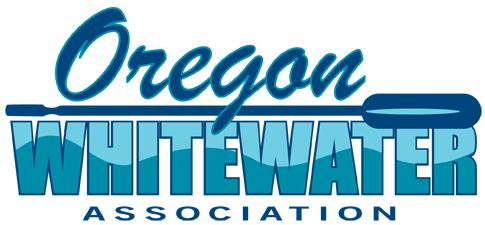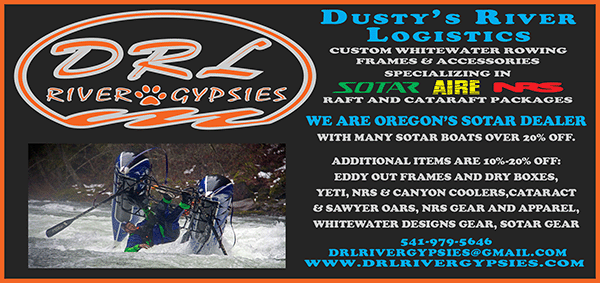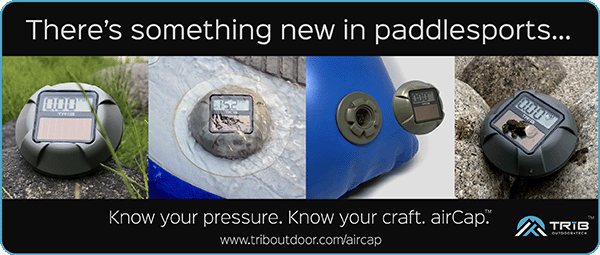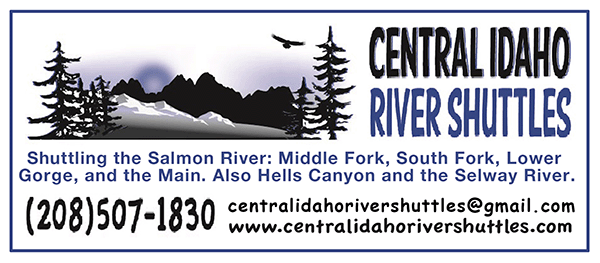Trip Report: Elochoman River - Jan 2018 - 650 cfs
A No Go on the Elochoman
Submitted by Tom Riggs
“NO JAKE” That is what the sign said on the pole as we were driving up the Elochoman River Road to do an exploratory run down this little known stream in southwest Washington. Brent, Doug, and I all looked at our Jake in the back seat of the shuttle pick up and said “looks like you can’t go”. The people who made the sign should have completed it with “NO DOUG, and NO BRENT” as we were to find out later that day.
American Whitewater has very limited information on the Elochoman and the guidebooks have even less, so in November I decided to take a drive up the watershed to look at a potential new run for me and most likely a new run for any of my gullible boating partners. On the road scout I crossed over the first concrete bridge and saw a nice gravel bar that had vehicle access and looked to be an obvious take out but was on private land so I continued up the road to the Department of Natural Resources, DNR, wayside next to the Elochoman Valley fire station.
This State access point had a narrow muddy trail through an overgrown thicket of blackberries that sort of made it to the river in a reed swamp. The gate that lead to the river had been there to control boat trailer traffic at one time but that was the only evidence that I was standing on what must have been a drift boat launch site. The trees and brush had taken this site back. I was not thwarted since American Whitewater said the take out is at the Beaver Creek Hatchery which I could see across the river just upstream of the weir. I drove over the bridge to the hatchery and walked about 70 yards from the parking area to get to the river. This access was also overgrown and packing a raft 70 yards isn’t out of the question but certainly is questionable.
Back adjacent to the DNR wayside was a nice riverside lot with an occupied trailer plus “no trespassing” signs. Well, in order get permission to trespass I had to trespass to knock on the door. I figured if things went awry I would resort to a zig zag pattern for escape, but the lady who opened the door was amicable and said she wasn’t the owner but pointed to the house across the highway, that needed a good coat of paint or at least the moss removed, as the landlord’s residence. The sign at his door only said “no solicitors” so I left my Amway goods in the truck and gave a knock. Ken answered the door and was fine with letting rafters land on his shoreline. He pointed out that the normal take out was the one I saw earlier at the concrete bridge and that everyone uses that as their departure point from the river. He said to just make sure to clean up any mess so the owners don’t change their mind about access. Other than that he didn’t say much about boating the river.
As I was walking back to my truck I saw three fellows in a 14 ft raft fishing just above the weir so I scooted down to query them about running the weir and their planned take out an put in. They said they were going to run the weir and drift down to the concrete bridge to end their trip. They also indicated there was a boat ramp about a mile upstream where they launched. Hey, that is the kind of information I was looking for. They had no knowledge of the rapids above their launch and I knew that a 3 mile trip on a meandering section of this river was too short of a run for most whitewater enthusiasts. I could find no one at the hatchery but there were vehicles there and things seemed to be open. They must have seen me coming and hid.
I drove up the river scouting what I could from the road and at a section where the river made a sharp left, there happened to be a guy in a fishing cat lining his boat around a tree growing horizontally out of the bank at Limbo level. It looked like a reasonable enough maneuver even for a larger cat or raft so it was duly noted in preparation for the club trip that I was planning. It was too late and too loud to talk to the fishing cat guy, but things were looking good. If there were two boats on this river on a Saturday in November there must be some extended runs upstream.
About a mile upstream from the fishing cat the pastoral terrain gave way to the beginning of a canyon and at the mouth is the abandoned fish hatchery. The bridge to this relic is closed but peering over the bank I could see a partial diversion weir that was runnable on river right. The entry to this obstacle was marked by some large rocks but easy enough to identify and with moderate skills all would have a clean run.
Continuing upstream the housing density decreased and there was a driveway that yielded a good view of the river. At this section there was another angled weir that partially crossed the river. I could not discern its purpose but it must have been from a bygone era and again with a little more skill could be skirted on river right with a maneuver to get back into the channel required at the bottom.
The road left the river by ½ mile as the canyon encroached so that section remained a mystery. When the river came back into view there was a turn out to the old logging road that paralleled the water for 200 yards. I was able to see a log that extended well out into the river so I worked my way through the brush to get a better view and could see that it was passable on the left as long as one was attentive to their rafting.
The next obstacle I saw on my drive upstream would have been a deal killer for most. It was a double spired alder that had been uprooted and fell all the way across the river except for a small 4 ft wide slot along the left bank. It’s just one little log I told myself and I bet we could bring a saw and mitigate this hazard to navigation. If not we could make a somewhat difficult but doable portage along the left bank. There could be more log obstacles I thought so I drove upstream and found a spur with a locked gate on Columbia Land Trust Land that invited hikers to enjoy their property. It was a squishy walk down to the water and I noticed several odd looking piles of wood stacked alternately along each bank in the river. These looked ominous but I could see they were man made fish habitat structures and with luck they would not snag wood and create log jambs before February’s planned descent.
It was hunting season and the various timber companies had their gates open which is not always the case as we were to find out. Breezing through the gate I passed over the West fork and spied a reasonable carry and launch point for boats if nothing upstream panned out. There was even an intersection nearby to help in turning around a raft trailer.
The AWA launch was on the North fork so I continued up stream for another mile and saw some good whitewater and pulled over for a better view. OK, the river was running at 1300 cfs at the mouth but there were large rocks creating a sieve course suitable for kayaks but too skinny for rafts. A nice set of class III rapids but just too bony so I drove a couple of miles up stream and found a wide spot in the road that the Kayak run must have been referencing as the put in.
Nothing to write home about so it was settled (or so I thought) that the West fork confluence would be the launch point.
I took down the phone number on the Columbia Land Trust sign and called their office to try to get more beta on the river run. Malone had been involved with the fish restoration project and said they had not placed any structures all the way across the river so that was good news. He also directed me to Steven Gray, the Washington State Fish biologist who works this area.
Steve responded to my email queries and each one sounded more ominous than the previous one. The warnings for the section above Twin bridges came as “passable, difficult and not advisable, but possible” and “I would not venture down below Twin Bridges in a raft pontoon/ cataraft. Not safe”. I did not see any twin bridges on my scout so perhaps he was referencing something above the West fork. …….or …..perhaps not.
Move the calendar ahead to January and the Elochoman is running about 650 cfs and I have talked Brent Davis and Doug Smith into being sacrificial probes for a more in depth exploration of this river in IKs. Well, Brent and Doug don’t have the corner on gullability because they were able to talk their buddy Jake into joining them as another IK-er while I provided shuttle and ground support.
I had heard rumors that the gate might be locked about 10 miles above the concrete bridge take out and that would deny us access to the planned launch at the West Fork another two miles upstream. Not to be worried “Ve haf our vays”. Someone came up with a key to the gate.
Brent and Doug being the map gurus they are did some aerial reconnasence via Google earth to try to pick out any obstacles they could find. Doug even had arranged a fly over in his buddy’s Cessna the week prior but fog at the Eugene airport kept them grounded. They did find an area with some whitewater that was not visible from the road so we planned to go cross country to find it. On our drive up river we stopped to look at the concrete bridge take out, the fish weir at the hatchery, the limbo log, the weir at the abandoned hatchery, and the unexplained weir upstream. Nothing that said “Stop the Presses!”
We found another gate we could park in front of and walked the long abandoned remnant of a logging road down to the river across a side stream and came across an abandoned bridge that had both approaches washed out. There was a little bit of a riffle and it was determined that was the Google Earth shot that we referenced. Certainly nothing of an issue there.
Next I knew I had to get into salesmanship mode because we would be looking at the double spired alder that spanned the river. Dang! It was still there. But wait guys…. I brought a pruning saw. Yes I said pruning, not chain. It would be so packable in your IKs and if worse came to worse you could still portage easily. Brent, Jake, and Doug were all good with the idea so I didn’t have to play my Ace in the hole and remind them that I was the shuttle driver and their cars were back in Portland.
The pavement ended and this time the gate was locked so Doug and I jumped out with the key to one of the 9 locks that secure the latch. It’s gotta be one of these but I couldn’t even get the key to fit into any of the locks. Doug certainly could do better and he did. He actually got the key to fit into one of the locks but that was it. It would not turn and we both jimmied and slid it in an out several times before we admitted defeat. The West fork launch was out.
Just before the gate however is a big turnout and remnants of a logging road along the river. Doug looked at the upper section of the turnout while Jake, Brent, and I walked down the road to check on places to launch an IK. Doug’s find was the lesser of all evils so we inflated and rigged their IKs and lowered them down the vertical slope to the bench below where launching would be quite manageable. To exacerbate matters Brent saw some old logging cable ends protruding from the dirt ready to scrape a hole in a person or a boat. All the while I am scratching my head as to how this goat path would work for getting rafts and catboats to the river.
It was time to launch the human probes. At 11:40 all boats were away and I was headed to the double spired alder.
The logging crew arrived at the alder in their IKs after successfully passing through the fish habitat work and were indeed able to skirt around the fallen tree on a slot on river right but concurred that passage for a raft would not be feasible. They tried to access the stump end of the log and made a few valiant attempts before giving up on that idea and paddling to the opposite shore. From high up on the bank I watched the three boaters take turns with the 10 inch pruning saw. After about 20 minutes they had one end sort of cut but needed to get further out in the river to cut a passage section for a raft.
Doug later shared that the first 1/3rd of the sawing went easy but the core of the tree was much harder and the going was slow. Again they took turns sawing and pushing and bouncing the log to break it. Another 20 minutes and they had cleared a route that a raft could slip through albeit you might want a lining rope on one end if the river were pushy. But if we could fit a raft through that would make the upcoming trip much smoother.
I drove downstream about 2 miles to catch the next photo op where there was a small set of rapids visible from the logging road. Twenty minutes, thirty minutes, 45 minutes, finally at one hour the three IKers were intact and floating on by below me. Did they stop to eat lunch? Did they have to portage? Was there a tavern on that section? Oh well, off to the next vantage point where a log was not quite spanning the entire river. As I arrived they were just paddling by with what appeared to be plenty of room.
Being the dutiful shuttler I looked through the trees as I was driving to find my next vantage point when I saw some whitewater down below. We had missed this on the scout in November and again on our drive up earlier that day. From high on the hill it looked like some large weir so I parked the truck to walk over the edge of the bank to get a better view. Oh it was another bridge.
I found another old logging road that lead down to the bridge which had both ends washed away.
The bridge was not the problem.
Upstream was a nice set of class III rapids that the crew would enjoy if they survived the death trap just above. The river was in a steep canyon and in this narrow slot was a log jam on river left with a limbo log right at the drop and in the drop was a 3 ft diameter log that looked like it had been there a while. This certainly was not runnable. Even if you made it under the limbo log it looked to me a boat/ person would get jammed underneath the log in the slot and be having dinner that night with King Neptune and Davey Jones.
I was struggling my way through the salal and blackberries trying to find a way to get upstream to alert the boaters of this hazard. That’s when I saw Doug’s red IK in the distance but I was looking through the foliage and could not tell where he was in relation to the log jam. These guys are all excellent boaters and this was not their first rodeo down exploratory runs. Prudence prevailed and they scouted the upcoming blind turn and saw the mess in the river. The glimpses of Doug’s boat I saw were of him portaging his craft through the forest above the river. They all found another abandoned overgrown logging road and made their way down to the access road where I was parked.
Needless to say, this upper section of the Elochoman is unrunnable in rafts. It turns out the long wait I had after the double alder was due to some other tight routes they had to navigate that sounded ill suited for larger craft. If you want a 3 mile fishing run on this river, put in at the roadside access point about a mile above the hatchery and go down to the concrete bridge.
We did find a tavern in Rainier on the way back.



